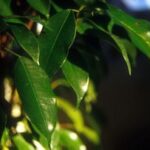There are over 800 varieties of plants belonging to the genus Ficus or figs. Figs are tropical or sub-tropical plants that are usually grown as houseplants, except for the edible fig (F. carica). Probably the most popular of the fig trees for home décor is the weeping fig (F. benjamina). I have known plenty of people, however, who have become disgusted with trying to keep this particular fig tree going in their home; because of its habit of dropping its leaves. Actually, there is a very simple trick to having a healthy and lush-looking fig tree.
The weeping fig can grow to be at least 6-feet-tall. (I have had a couple that grew to be a little taller, though. I guess they were happy.) You can prune your fig tree just like any other tree, however, to keep it in check. You should also cut away any dead or disfigured branches.
Plant your weeping fig in a large container, because you really do not want to have to transplant it later if at all possible. Fill about half of the pot with crumpled newspapers. This will help to make the pot lighter, plus you will not have to use as much potting soil, saving yourself some money. (In addition, this is a great way to recycle your old newspapers.) You need only use a good potting soil. (I use Miracle-Gro.) Keep your weeping fig evenly moist but not soggy. I always use a water-soluble fertilizer about once a month or so. Give your weeping fig some light but make sure it is indirect light. After you have done all of this, you may come back to me to let me know that it is dropping leaves.
A weeping fig tree’s tendency to drop leaves is probably the main reason that many people get frustrated with this plant (as mentioned at the beginning of this article) and decide to just toss it. Weeping fig trees, although they are evergreen, can start dropping their leaves until their delicate-looking, twiggy branches are almost completely bare – for no apparent reason. However, there is indeed a reason for the leaf drop; and it can be easily corrected. Once you have set your weeping fig tree where you want it in your house, do not move it at all. Do not turn it periodically so different sides can receive sunlight. Do not move it an extra inch from the wall. Do not move it from one wall to another. Leave it alone. You see, weeping fig trees go into shock easily. (This is the reason I told you earlier to plant your weeping fig in a large container so you would not have to transplant it into another pot as it grew.) If you even turn your fig tree, it will go into shock and start dropping its leaves. Decide where you want your weeping fig to be, put it there, and never move it again. If for some reason, you do need to move it, understand that it will start dropping its leaves, resulting in the need for a rake. (That was a bit of a joke.) It will snap out of it, though, and start producing new leaves. Nevertheless, refrain from moving it if at all possible. If you follow this simple advice, you will have a large and absolutely beautiful fig tree – complete with leaves attached.
For other indoor gardening tips, see:
Seeds to start indoors during the winter
How to Force Bulbs to Flower in Winter


